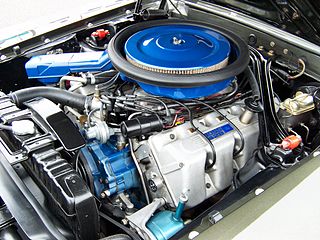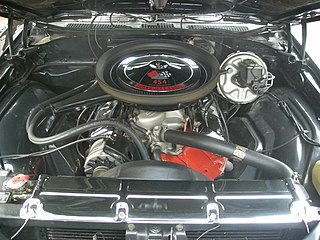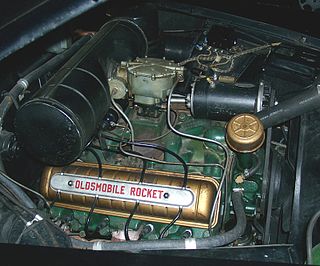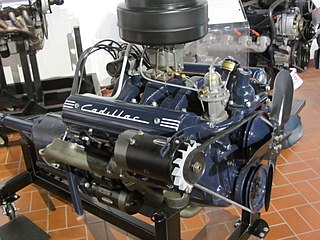| GMC V6 engine | |
|---|---|
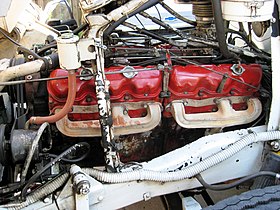 GMC "Twin Six" heavy duty engine 702 cu in (11.5 L) | |
| Overview | |
| Manufacturer | General Motors |
| Production | 1959–1974 |
| Layout | |
| Configuration | 60° V6, V8, and V12 |
| Displacement |
|
| Cylinder bore |
|
| Piston stroke |
|
| Cylinder block material | Cast iron |
| Cylinder head material | Cast iron |
| Valvetrain | OHV 2 valves × cyl. |
| Combustion | |
| Fuel system | Carburetor |
| Fuel type | Gasoline and diesel |
| Cooling system | Water-cooled |
| Output | |
| Power output | 150–275 hp (112–205 kW) [1] [2] |
| Torque output | 260–630 lb⋅ft (353–854 N⋅m) [3] [4] |
The GMC V6 is a family of 60-degree V6 engines produced by the GMC division of General Motors from 1959 through 1974. It was developed into both gasoline and diesel versions, and produced in V8 and V12 derivatives. Examples of this engine family were found in pickup trucks, Suburbans, heavier trucks, and motor coaches.
Contents
- Gasoline V6
- 305
- 351
- 379
- 401
- 432
- 478
- Gasoline V8
- 637
- Gasoline V12
- 702
- Diesel V6
- D351
- D478
- DH478
- Diesel V8
- D637
- DH637
- See also
- References
A big-block engine, variants were produced in 305-, 351-, 401-, and 478-cubic-inch (5.0, 5.8, 6.6, and 7.8 liters respectively) displacements, with considerable parts commonality. During the latter years of production, 379-and-432-cubic-inch (6.2 and 7.1 L) versions with enlarged crankshaft journals were manufactured as well.
GMC produced a 637-cubic-inch (10.4 L) 60° V8 with a single camshaft using the same general layout (bore and stroke) as the 478 V6. The 637 V8 was the largest-displacement production gasoline V8 ever made for highway trucks.
The largest engine derived from the series was a 702-cubic-inch (11.5 L) "Twin Six" V12, which had a unique block and crankshaft, but shared many exterior parts with the 351.
Diesel versions of the 351, 478 and 637, advertised as the ToroFlow, were also manufactured. These engines had no relationship to the well-known Detroit Diesel two-stroke diesel engines produced by General Motors during the same time period.
All versions of the GMC V6 used a six-throw crankshaft, which when combined with the 60 degree included cylinder angle, produced a smooth-running engine without any need for a balance shaft. Spark plugs were located on the inboard side of the cylinder heads and were accessed from the top of the engine. This position allowed for shorter spark-plug wires and kept the spark plugs away from the hot exhaust manifolds, something which was emphasized in sales literature. It was also perceived as being easier to access for maintenance. These GMC V6 engines were noted for durability, ease of maintenance, and strong low-end torque.
In 1974, GMC discontinued the V6 engine; all gasoline-engine models were powered by Chevrolet straight-six and V8 engines, while diesel engines were dropped from medium duty models and would not return until 1976.
| GMC 60° Engine Family | |||||||
|---|---|---|---|---|---|---|---|
| Fuel | Cylinders | Model | Displacement | Bore | Stroke | Power (Net) | Torque (Net) |
| Gasoline | 6 | 305A [5] | 304.6 cu in (5.0 L) | 4.25 in (108 mm) | 3.58 in (91 mm) | 125 hp (93 kW) | 240 lb⋅ft (325 N⋅m) |
| 305B [5] | 304.6 cu in (5.0 L) | 4.25 in (108 mm) | 3.58 in (91 mm) | 127 hp (95 kW) | 245 lb⋅ft (332 N⋅m) | ||
| 305C [6] | 304.6 cu in (5.0 L) | 4.25 in (108 mm) | 3.58 in (91 mm) | 142 hp (106 kW) | 250 lb⋅ft (339 N⋅m) | ||
| 305D [7] | 304.6 cu in (5.0 L) | 4.25 in (108 mm) | 3.58 in (91 mm) | 142 hp (106 kW) | 260 lb⋅ft (353 N⋅m) | ||
| 305E [8] | 304.6 cu in (5.0 L) | 4.25 in (108 mm) | 3.58 in (91 mm) | 142 hp (106 kW) | 260 lb⋅ft (353 N⋅m) | ||
| 351/351C [6] | 351 cu in (5.8 L) | 4.56 in (116 mm) | 3.58 in (91 mm) | 155 hp (116 kW) | 288 lb⋅ft (390 N⋅m) | ||
| 351E [5] | 351 cu in (5.8 L) | 4.56 in (116 mm) | 3.58 in (91 mm) | 190 hp (142 kW) | 304 lb⋅ft (412 N⋅m) | ||
| 351M [5] | 351 cu in (5.8 L) | 4.56 in (116 mm) | 3.58 in (91 mm) | 190 hp (142 kW) | 304 lb⋅ft (412 N⋅m) | ||
| 379 [5] | 379 cu in (6.2 L) | 4.56 in (116 mm) | 3.86 in (98 mm) | 170 hp (127 kW) | 266 lb⋅ft (361 N⋅m) | ||
| 401 [5] | 401 cu in (6.6 L) | 4.875 in (123.8 mm) | 3.58 in (91 mm) | 178 hp (133 kW) | 351 lb⋅ft (476 N⋅m) | ||
| 401M [9] | 401 cu in (6.6 L) | 4.875 in (123.8 mm) | 3.58 in (91 mm) | 210 hp (157 kW) | 348 lb⋅ft (472 N⋅m) | ||
| 432 [5] | 432 cu in (7.1 L) | 4.875 in (123.8 mm) | 3.86 in (98 mm) | 190 hp (142 kW) | 336 lb⋅ft (456 N⋅m) | ||
| 478 [5] | 478 cu in (7.8 L) | 5.125 in (130.2 mm) | 3.86 in (98 mm) | 206 hp (154 kW) | 400 lb⋅ft (542 N⋅m) | ||
| 478M [9] | 478 cu in (7.8 L) | 5.125 in (130.2 mm) | 3.86 in (98 mm) | 225 hp (168 kW) | 410 lb⋅ft (556 N⋅m) | ||
| 8 | 637 [5] | 637 cu in (10.4 L) | 5.125 in (130.2 mm) | 3.86 in (98 mm) | 250 hp (186 kW) | 560 lb⋅ft (759 N⋅m) | |
| 12 | 702 [5] | 702 cu in (11.5 L) | 4.56 in (116 mm) | 3.58 in (91 mm) | 250 hp (186 kW) | 585 lb⋅ft (793 N⋅m) | |
| Diesel | 6 | D351 [10] | 351.2 cu in (5.8 L) | 4.56 in (116 mm) | 3.58 in (91 mm) | 118 hp (88 kW) | 234 lb⋅ft (317 N⋅m) |
| D478 [10] | 477.7 cu in (7.8 L) | 5.125 in (130.2 mm) | 3.86 in (98 mm) | 135 hp (101 kW) | 266 lb⋅ft (361 N⋅m) | ||
| DH478 [10] | 477.7 cu in (7.8 L) | 5.125 in (130.2 mm) | 3.86 in (98 mm) | 155 hp (116 kW) | 298 lb⋅ft (404 N⋅m) | ||
| 8 | D637 [9] | 637 cu in (10.4 L) | 5.125 in (130.2 mm) | 3.86 in (98 mm) | 185 hp (138 kW) | 440 lb⋅ft (597 N⋅m) | |
| DH637 [9] | 637 cu in (10.4 L) | 5.125 in (130.2 mm) | 3.86 in (98 mm) | 205 hp (153 kW) | 444 lb⋅ft (602 N⋅m) | ||
